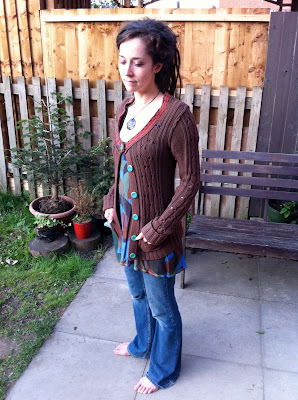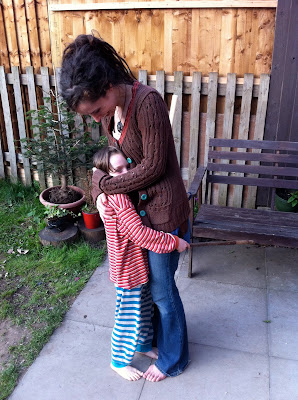You might be led astray by this title, thinking I am going to debate the environmental (un)ethics of dyeing. Nope. This is just a little chit-chat about all the colour-changing I've been up to!
A few Sundays ago, I took advantage of our partially sunny, very windy weather and did three dye washes, hanging them out in the fresh breeze to dry.
A few Sundays ago, I took advantage of our partially sunny, very windy weather and did three dye washes, hanging them out in the fresh breeze to dry.
This is always a community thing. I text a few friends, telling them which colours I'm doing, and they'll bring bits and pieces round to add to the loads. Then I open the wardrobe, a small one that Dan and I both share, and from my collection of clothing I pull out whatever I can find that hasn't been worn in a while. The prevailing question is: can it be dyed? If not, it's thrown straight into a charity shop bag. If so, onto the dye pile it goes.
I don't seem to remember to take before pictures. Ever. But here are a few recent pieces after their colour rejuvenation.
People Tree cotton recycled sari dress from last year, purchased in the sales for £12... now my favourite shade of green! Dyeing this once buttery yellow dress green muted the contrasts, previously light brown and cream, to dark brown and grass green. (worn with a t-shirt that was originally red, now plum after going through a blue wash)
Same dress, worn as a skirt
Miss Selfridge dress, purchased new four years ago, originally cream/brown/yellow combination; went through a blue wash. Now blue/brown/green.
This is one of my favourites. When I found this cardigan on a sale rack at Old Navy while on a trip to the States three years ago, I could not pass it up. Why? It was only FIVE DOLLARS! I loved it. The style and fit were perfect. However, the colour, identical to the green buttons, never quite did it for me. I found this particular shade of green a difficult one to match -and I use 'match' lightly because most of my clothes don't 'match'- but the colour tones have to go together. I've needed a brown cardigan for a long time, so this went into a red dye wash. The white lines around the neckline turned red, and the green cardigan with the tiny front pockets turned a lovely rich shade of brown. The colour tone is perfect; it goes with almost everything! The only work remaining on this cardigan is to replace the green plastic buttons with wooden ones.
Mr J decided to steal a hug in the middle of all the photo-taking!
This is a floaty, cotton, Indian-made top that has virtually no shape but is still flattering, with some lovely embroidery. I've had it for fourteen years, but have gone through long phases of not wearing it because the colour -sullen green with splotches of yellow and pink- never really complimented my colouring. I like it a million times better after a purple wash.
A few things to remember about dyeing:
- Start with clean clothing, stains removed if possible
- Check the fabric content: 100% cotton is best, but any cotton mix will generally produce some colour change. Wool and most artificial fabrics will not dye.
- Machine dye if possible. I find this produces the best results: even and long-lasting.
- Follow the instructions on the dye packet carefully; don't forget the salt!
- The less items in a dye wash, the darker it will be; and vice-versa
- If you're unsure about the colour you will end up with, do some coloured pencil scribbles to mix the 'before' colour with the colour of the dye wash. This usually gives a fairly accurate idea of the finished colour.
When I began dyeing more often using conventional dyes [such as Rit and Dylon], I also spent time researching natural dyeing methods. After an extensive amount of reading and trying to understand natural dyeing processes, I realised that even if I were to embark on the huge amount of work that natural dyeing methods would entail, it would still be necessary to use chemicals and unnatural substances to set the natural dyes. If I ever have the space needed and the necessary hours available someday, I'd love to try this out. And grow all the amazing plants used for natural dyes, and spend time cultivating old-fashioned dye pots, etc.
Right now, my life is just a little bit too crazy. I have stacks of soap-making supplies in my cupboard, waiting to be used. I've just begun a photo-organising project which includes making a few scrapbooks. These are just two of many creative ventures scattered half-started all over my house.
So for now, I'm going to leave natural dyeing to the experts and use these little boxes of Dylon to achieve colour magic.







Your dyeing craze is catching on...I have two dyed shirts in my closet right now...
ReplyDeleteThanks for sharing!